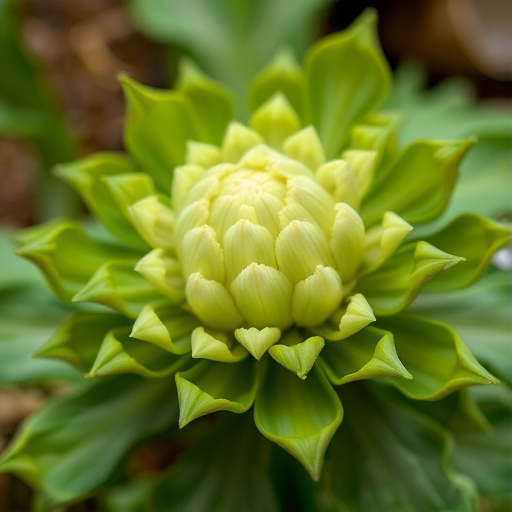In a groundbreaking study published in the Journal of Antibiotics, researchers have presented the taxonomic characterization of a novel actinobacterium strain named HUAS ZL42^T, isolated from the leaves of the artichoke, Cynara scolymus. This research adds significant depth to our understanding of the Streptomyces genus and highlights the biodiversity present within this group of bacteria. The study was meticulously conducted using a polyphasic methodology, which is essential for accurate species classification, especially in a genus as complex as Streptomyces.
The strain itself, HUAS ZL42^T, exhibits distinctive morphological properties. It produces spiral spore chains composed of rod-shaped or ovoid spores, which possess smooth surfaces when cultured on Gause’s synthetic No. 1 medium. These characteristics not only help in its identification but also provide insight into the ecological role of this microorganism in its natural habitat. Such unique spore formations and morphology are critical when delineating closely related species, serving as essential phenotypic traits for identification.
In terms of its biochemical composition, strain HUAS ZL42^T exhibits a noteworthy cell wall structure that contains ll-diaminopimelic acid, confirming its classification as an actinobacterium. Whole-cell hydrolysate analyses revealed the presence of sugars such as galactose and mannose, compounds that play essential roles in cellular processes and could contribute to the strain’s metabolic pathways. This information furthers our understanding of the strain’s nutritional and ecological adaptability.
The fatty acid profile of strain HUAS ZL42^T is another critical aspect of its characterization. With predominant cellular fatty acids including iso-C14:0, anteiso-C15:0, and iso-C16:0, this biochemical signature aligns with recognized patterns in the genus, enabling further taxonomic comparisons. The detailed fatty acid analysis presents a biochemical fingerprint that can be vital for understanding its ecological interactions and potential uses in biotechnology or pharmaceutical applications.
Menaquinone analysis, which revealed MK-9 (H6), MK-9 (H4), and MK-9 (H8) as the primary menaquinones in HUAS ZL42^T, provides additional layers to its biochemical classification. Menaquinones are essential components of the electron transport chain, and their presence may significantly impact the metabolic adaptability of strain HUAS ZL42^T to varied environmental conditions.
The genomic examination further clarified the phylogenetic relationships of strain HUAS ZL42^T. The 16S rRNA gene sequence analysis revealed that this strain shares a high similarity with Streptomyces cyslabdanicus K04-0144^T and Streptomyces cinnabarigriseus JS360^T at 98.6%, suggesting close evolutionary ties. However, phylogenetic analysis derived from five housekeeping gene sequences positioned HUAS ZL42^T within a distinct subclade, underscoring its novelty.
The genomic comparisons, quantified through Average Nucleotide Identity (ANIm) and digital DNA-DNA hybridization (dDDH), indicated an ANIm of 87.17% and dDDH of 28.90% in relationship to S. cyaneus CGMCC 4.1671^T. Given that these values fall significantly below the respective cut-off points of 96.7% and 70% recommended for species delineation in the Streptomyces genus, this finding robustly reinforces the classification of HUAS ZL42^T as a novel species.
In light of these extensive phenotypic and genotypic differentiations, the study culminates in the proposition that strain HUAS ZL42^T should be designated as a new species within the Streptomyces genus, specifically termed Streptomyces secundicynarae sp. nov. This declaration not only enriches the Streptomyces taxonomy but also opens avenues for exploring its potential roles in ecology and biotechnology.
The implications of such discoveries extend beyond mere classification; they invite questions about the ecological functions of newly identified species like Streptomyces secundicynarae. Understanding their interactions with plant hosts, their roles in nutrient cycling, and potential applications in biocontrol or as sources of novel bioactive compounds can have far-reaching consequences in agriculture and pharmaceuticals.
Overall, the discovery of strain HUAS ZL42^T adds to the rich tapestry of actinobacterial diversity, highlighting the importance of exploring understudied environments such as the foliage of medicinal plants. As researchers continue to unveil new species, the global implications for biodiversity, conservation, and biotechnological innovation remain monumental.
Through this comprehensive analysis, the researchers not only solidified the classification of a new actinomycete species but also illuminated the intricate relationships that exist within microbial communities. The study stands as a testament to the importance of thorough taxonomic assessments in understanding the complex web of life present in our ecosystems.
In conclusion, the advent of Streptomyces secundicynarae represents not merely an addition to the scientific catalog but also a beacon of the untapped potential that lies within diverse microbial environments. With ongoing research, the full impact of such discoveries will undoubtedly unfold in the coming years, offering novel insights and applications that could transcend academic realms and touch upon global scientific advancements.
Subject of Research: Isolation and characterization of a novel actinobacterium.
Article Title: Streptomyces secundicynarae sp. nov., a novel actinomycete isolated from the leaves of Cynara scolymus.
Article References:
Song, Y., Tang, T., Mo, P. et al. Streptomyces secundicynarae sp. nov., a novel actinomycete isolated from the leaves of Cynara scolymus.
J Antibiot 78, 593–599 (2025). https://doi.org/10.1038/s41429-025-00853-4
Image Credits: AI Generated
DOI: September 2025
Keywords: actinobacteria, Streptomyces, microbial diversity, taxonomic classification, biotechnology




